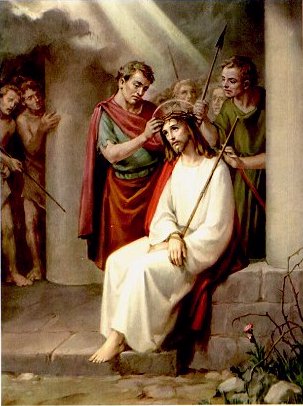Yesterday I mentioned that I’d had somewhat of an
epiphany regarding the Mysteries of the Rosary. Today, all shall be revealed!! So what did I notice, exactly?
Namely, that if one takes all the third Mysteries,
for example, from each of the groups (i.e. The Nativity, The Proclamation of
the Kingdom, The Crowning of Thorns, and Pentecost) one can trace the outlines of some pretty interesting thematic contours.
 |
| The Crowing of Thorns |
In other words, one can group the Mysteries into
themes in a way (or even ways) other than the Joyful, Luminous, Sorrowful and
Glorious.
The
Standard Narrative
The way the Mysteries are usually put together is
strictly chronologically, with the overall pattern of:
- Times of joy in Christ’s life, before His public ministry
- Times of especial light (or revelation) about Who He is
- The sorrows of His Passion and Death
- The glories that followed
I have always thought of them as basically a
chronological overview of Christ’s life, which we reflect upon with His Mother,
so that, meditating upon these events which are full of significance, we might
“imitate what they contain and obtain what they promise”.
I never thought, until recently, to compare
corresponding mysteries with each other, to see how else they might fit
together, and what light they might thereby shed on each other. (Such an idea may, of course, be extended to include reflections that compare the Mysteries of the Rosary with other events in Sacred Scripture, whether from the Old or the New Testament.)
I am going to argue, by looking at each set of corresponding Mysteries in turn, that what we have going on here
is a bit of recapitulation and prolepsis. Ok, what is that? I'll do a bit of quoting from my summary of Dr Robert Tilley's paper Tradition, Temporality and Transcendence: A Biblical Ontology of Time and Space, presented at the Tradition Conference:
The Bible’s recapitulative logic consists in the notion that time and space interact such that the “past is really and truly repeated in the present” and this is perfected and fulfilled in the human person, specifically in the mediating covenant representatives. Prolepsis means that the “present can, in some manner, truly participate in the future, in that what is in the future is the locus of their fulfilment and perfection."
In other words, the Biblical conceptions of time and space are such that it presents history simultaneously repeating itself (after something has happened), but also participating in the future (before it has happened), and this is perfected and fulfilled in the liturgy. This presentation of reality is evident throughout the Scriptures and
salvation history, and I think in the Mysteries of the Rosary we have a microcosm of this broader reality going on, focused here specifically around Christ’s coming and His
work of salvation. Hopefully these somewhat abstract statements will become clear(er) in future posts!
Next time: The First Mysteries
+AMDG
No comments:
Post a Comment